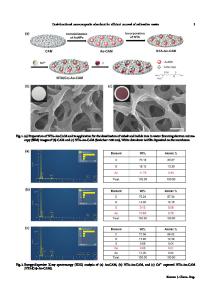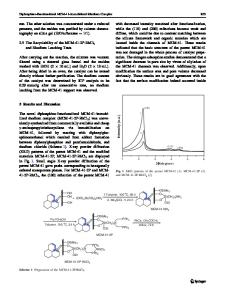Dendritic fibrous nanosilica functionalized by dithiocarbamate as a highly efficient adsorbent for the removal of malach
- PDF / 929,932 Bytes
- 8 Pages / 595.276 x 790.866 pts Page_size
- 44 Downloads / 362 Views
ORIGINAL PAPER
Dendritic fibrous nanosilica functionalized by dithiocarbamate as a highly efficient adsorbent for the removal of malachite green from waste water based on electrostatic interaction Mahsa Anvari1 · Nasrin Shadjou1 Received: 17 April 2020 / Revised: 11 August 2020 / Accepted: 24 August 2020 © Islamic Azad University (IAU) 2020
Abstract In this work, dithiocarbamate (-NH-CS2)-functionalized dendritic fibrous nanosilica (KCC-1) with significant adsorbtion capacity was effectively synthesized using the reliable reaction process. Field emission scanning electron microscopy, FT-IR and transmission electron microscopy were used to analyze particle size and morphology of nanoadsorbent. Additionally, the functionalization of bare materials (dendritic fibrous nanosilica) with dithiocarbamate was confirmed with FT-IR and energy-dispersive X-ray spectroscopy. Furthermore, nitrogen adsorption/desorption analysis (BET equation) was utilized to evaluate KCC-1-NH-CS2 porosity (surface are, pore size, pore volume). The UV–Vis spectrophotometric method was used to evaluate organic dye removal from aqueous solutions. It was found that dithiocarbamate-functionalized KCC-1-NH2 with narrow size distribution, high surface area (133 m2/g) and effortlessly available pores had good potential for highly efficient removal of malachite green (MG) from contaminated waters. Electrostatic interactions between the negatively charged dithiocarbamate group (NH-CS2−) of nanoadsorbent and cationic MG in KCC-1-NH-CS2 channels provided a rapid (45 min) removal of this organic contaminated agent from waste water with adsorbtion capacity higher than 98%. Finally, an efficient nanoadsorbent was introduced to remove organic dyes from wastewaters and industrial purification. Keywords Malachite green · Water pollution · Dye removal · Electrostatic interaction · Nanosilica · Adsorbent
Introduction Removal of dyes from waste waters is an important issue in textile and paper industries (Roosta et al. 2014; Daneshvar et al. 2007; Kaith et al. 2015). Malachite green (MG) is a popular cationic dye. MG (Fig. 1) is a harmful dye for human health leading to headache, high heartbeat and irritation of the eyes (Zhuang et al. 2016; Hosseinzadeh and Abdi 2017; Lu et al. 2015; Stammati et al. 2005). Therefore, removal of this dye from industrials wastewaters is extremely important Editorial responsibility: Hari Pant. Electronic supplementary material The online version of this article (https://doi.org/10.1007/s13762-020-02911-w) contains supplementary material, which is available to authorized users. * Nasrin Shadjou [email protected] 1
Nanotechnology Research Group, Faculty of Science, Urmia University, Urmia, Iran
for the environmental science and technology. To date, some materials such as bio-sorption, filtration, ozonization and oxidation have been used to remove MG from aqueous solutions (Kusvuran et al. 2011; Sajab et al. 2016; Doke and Yadav 2014; Wu et al. 2015; Tsai and Chen 2010; Guenfoud et al. 2014). It is important to point ou
Data Loading...











